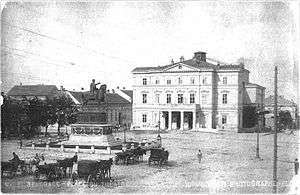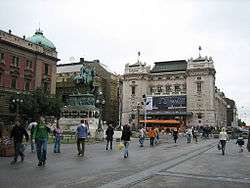Republic Square (Belgrade)

Republic Square or Square of the Republic (Serbian: Трг републике / Trg republike) is one of the central town squares and an urban neighborhood of Belgrade, located in the Stari Grad municipality. It is the site of some of Belgrade's most recognizable public buildings, including the National Museum, the National Theatre and the statue of Prince Michael.[1]
Location
The square is located less than 100 meters away from Terazije, designated center of Belgrade, to which it is connected by the streets of Kolarčeva (traffic) and Knez Mihailova (pedestrian zone). Many people erroneously consider Square of the Republic to be the center of the city. Through Vasina street it is connected to the fortress and park of Kalemegdan to the west and through Sremska street it is connected to the neighborhood of Zeleni Venac and further to Novi Beograd. It also borders the neighborhoods of Stari Grad and Dorćol, to the north. Today, it makes one of the local communities within Belgrade with a population of 2,360 in 2002.
History
Origin


The present square was formed after the demolition of the Stambol Gate in 1866 and the construction of the National Theatre in 1869. The gate was built in the 18th century by the Austrians, and stood in the area between the present Prince Mihailo monument and the National Theatre building. The gate was named after the road which led through it to Constantinople. The people remembered the Stambol Gate as the place in front of which the Turks executed the "raya", their non-Muslim subjects, by impaling them on stakes. It was also the place where during the attack on Belgrade in 1806 in the First Serbian Uprising, one of the leading Serb military commanders, Vasa Čarapić, was fatally wounded. In memory of this sad event, a street near the square and a monument in the vicinity were named after him.[1]
After the establishment of Serbian rule and the demolition of the Stambol Gate, the site of the present square was not laid out for a long time. The National Theatre was the only large building standing here for more than thirty years and until Communist rule after 1945 it was named Pozorišni Trg (Theatre square). The square gradually started to acquire more buildings after the monument to Prince Mihailo was erected in 1882. The place where now the National Museum is, was the location of long single-storied building which housed, among other things, the famous "Dardaneli restaurant". This was the meeting-place of members of the artistic circles at the time. The building was pulled down to make way in 1903 for the Treasury (now the building of the National Museum). In a small park next to the National Theatre, there were the well-known "Kolarac" restaurant and cinema (owned by Ilija Milosavljević-Kolarac, a merchant and benefactor). The "Riunione" Palace, in which the "Jadran" cinema is located today, was built in 1930.
World War II and later
Most of the buildings were destroyed during the German bombing on April 6, 1941. After World War II the tram tracks were removed (until then, a tram terminus was here), and the square, on which for a short time were the crypt and the monument to the Red Army soldiers died during the Belgrade Offensive in 1944, was removed (their remains have been transferred to the Cemetery of the Liberators of Belgrade).[1] Later, the biggest building on this square, the "Press House" was constructed, so as the "City Restaurant" and the International Press Center.
Opera controversy
The area of the present 'Plateau of Dr Zoran Đinđić', right across the National Theatre was seen for decades as the site of the future Belgrade Opera. However, this became highly controversial issue, both academic and public, in the 2000s, when city government decided to tear down the Staklenac mall (saying it has done its purpose, even though it was built in 1989) and to construct City Gallery, while the Opera is supposed to be built in the swampy and uninhabited area of Ušće in Novi Beograd. Despite opposition from the population, ensemble of the opera and prominent architects and artists, the city government, most prominently the official city architect Đorđe Bobić, insists that regardless of everything, they already made a decision that the Opera will not be built on the Square.
Name
The name of the square has been the subject of much debate in the city. Vuk Drašković of the Serbian Renewal Movement suggested the square be renamed to Freedom Square (Trg Slobode) after pro-democracy demonstrations were held in the square to oust Slobodan Milosević in the 1990s.[1] Most recently, a group of theater academics suggested the square's original name Theater Square (Pozorišni trg) be returned.[2]
Characteristics
The square is one of the busiest places in Belgrade, as one of the central business areas in the city, with over 20 bus and trolleybus lines of the city public transportation passing through the square.
On one side, the square extends to the Knez Mihailova street, the pedestrian zone and one of the main commercial sections of Belgrade. On the opposite side, the square is occupied by the Staklenac (Serbian for glassy), the Belgrade's first modern glass and steel constructed shopping mall, built in 1989 for the purpose of the IX Non-Aligned Movement summit in Belgrade. The small flat area in front of Staklenac has been officially named 'Plateau of Dr Zoran Đinđić', after the Serbian prime minister was assassinated in 2003.
Prince Michael monument

The bronze statue of Prince Michael on a horse, by the Italian sculptor Enrico Pazzi was erected in 1882. It was erected in honor of the Prince's most important political achievement, complete expulsion of the Turks from Serbia and liberation of the remaining 7 cities within (then) Serbian territory, still under the Turkish rule (1867). The names of the cities are carved on a plates on the monument itself, on the statue's pedestal and prince is sculptured with his hand allegedly pointing to Constantinople, showing the Turks to leave. During recent years, the role and honor of prince somewhat fell into the oblivion and the statue became simply known as kod konja (Serbian for 'at the horse'). Even the nearby restaurant is named that way, Kod konja.
Millennium clock
In 2000, a modern public clock, named the Millennium clock and funded by Delta Holding, was installed in the square. The clock is placed on a tall stand, and it also displays current weather conditions. Two main, digital clocks face the less busy sides of the square (near Čika Ljubina and Kolarčeva streets), while two small, analog clocks face the two busier sides (near Knez Mihailova street and the National Theatre). The clock and its stand are made of chromed steel and glass.
With the addition of the clock, Belgraders are now more likely to say 'Let's meet at the clock' than 'at the horse'.
References
- 1 2 3 4 "Beograd: Trg Republike ne menja ime" (in Serbian). Večernje novosti. 11 January 2013. Retrieved 3 February 2013.
- ↑ "Umetnici: Trgu Republike vratiti stari naziv" (in Serbian). Večernje novosti. 3 January 2013. Retrieved 3 February 2013.
External links
| Wikimedia Commons has media related to Republic Square (Belgrade). |
Coordinates: 44°48′59.2″N 20°27′36.4″E / 44.816444°N 20.460111°E